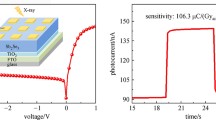Abstract
Well designed scintillator detectors, including such examples as ARSA, SAUNA, and XIA’s “PhosWatch”, can readily achieve the state of the art radioxenon detection limits required for nuclear explosion monitoring. They are also reliable, robust detectors that do not require cryogenic cooling for operation. All three employ the principle of beta-gamma coincidence detection to reduce background counting rates, using a BC-404 plastic scintillator to detect the betas and a CsI or NaI scintillator to detect the gamma-rays. As a consequence of this commonality of design, all three also display a “memory effect” arising from the diffusion of Xe into BC-404. Thus, when one sample is pumped out of the detector, a fraction remains behind, embedded in the BC-404, where it artificially raises the signal counting rate for the next sample. While this is not a fatal flaw in scintillator detectors, developing a method to eliminate the memory effect would significantly enhance their utility. This paper reports efforts to develop thin, amorphous Al2O3 films, deposited by atomic layer deposition (ALD) to act as diffusion barriers on the BC-404 surfaces exposed to radioxenon. Using radon as a convenient substitute for Xe, film thicknesses between 2 and 10 nm were originally investigated and found to show a memory effect to varying degrees. A second set of 20 and 30 nm films was then produced, which appeared to completely eliminate the radon memory effect, but, when consequentially tested with radioxenon, were found to exhibit xenon memory effects that were approximately half of the effect found on uncoated BC-404. We draw two conclusions from this result. The first is that it will be necessary to develop an improved method for depositing thicker ALD Al2O3 films at lower temperatures while still retaining high film quality. The second is that, since xenon is required to test for the xenon memory effect, we need a test method that does not require xenon radio-isotopes in order to facilitate screening large numbers of samples.









Similar content being viewed by others
References
Hennig W, Warburton WK, McIntyre JI (2006) IEEE Trans Nucl Sci 53:620
Hennig W, Warburton WK, Fallu-Labruyere A, Sabourov K, Cooper MW, McIntyre JI, Gleyzer A, Bean M, Korpach EP, Ungar K, Zhang W, Mekarski P (2009) J Radioanal Nucl Chem 282:681
Ringbom AT, Larson T, Axelson A, Elmgren K, Johansson C (2003) Nucl Instr Meth Phys Res A 508:542
McIntyre JI, Abel KH, Bowyer TW, Hayes JC, Heimbigner TR, Panisko ME, Reeder PL, Thompson RC, Radioan J (2001) Nucl Chem 248:629
Seifert CE, McIntyre JI, Antolick KC, Carman AL, Cooper MW, Hayes JC, Heimbigner TP, Hubbard CW, Litke KE, Ripplinger MD, Suarez R (2006) In: Proceedings of 27th seismic research reviews: ground-based nuclear explosion monitoring technologies, LA-UR-05-6507, vol II, pp 804–814
Kalinowski MB, Becker A, Saey PRJ, Tuma MP, Wotowa G (2008) Complexity 14:89
Auer M, Kumberg T, Sartorius H, Wernsperger B, Schlosser C (2010) Pure Appl Geophys 167:471
George SM (2010) Chem Rev 110:113
Groner MD, Fabreguette FH, Elam JW, George SM (2004) Chem Mater 16:639
Groner MD, George SM, McLean RS, Carcia PF (2006) Appl Phys Lett 88:051907
Wilson CA, Grubbs RK, George SM (2005) Chem Mater 17:5625
Warburton WK, Asztalos SJ, Hennig W (2011) In Proceedings of 2011 monitoring research review: ground-based nuclear explosion monitoring technologies, LA-UR-11-4823, vol II, pp 731–740
Clementi E, Raimondi DL, Reinhardt WP (1967) J Chem Phys 47:1300
Hennig W, Chu YX, Tan H, Fallu-Labruyere A, Warburton WK, Grzywacz R (2007) Nucl Instr Meth Phys Res B 263:175
Saint-Gobain Data Sheet. BC-400, BC-404, BC-408, BC-412, BC-416 Premium Plastic Scintillators. www.detectors.saint-gobain.com
Carcia PF, McLean RS, Reilly MH, Groner MD, George SM (2006) Appl Phys Lett 89:031915
Bläckberg L, Fay A, Jogi I, Biegalski S, Boman M, Elmgren K, Fritioff T, Johansson A, Mårtensson L, Nielsen F, Ringbom A, Rooth M, Sjöstrand H, Klintenberg M (2011) Nucl Instr Meth Phys Res A 656:84
Zaitseva N, Carman L, Glenn A, Newby J, Faust M, Hamel S, Cherepy N, Payne S (2011) J Crystal Growth 314:163
Author information
Authors and Affiliations
Corresponding author
Rights and permissions
About this article
Cite this article
Warburton, W.K., Hennig, W., Bertrand, J.A. et al. Atomic layer deposition α-Al2O3 diffusion barriers to eliminate the memory effect in beta-gamma radioxenon detectors. J Radioanal Nucl Chem 296, 541–549 (2013). https://doi.org/10.1007/s10967-012-2061-y
Received:
Published:
Issue Date:
DOI: https://doi.org/10.1007/s10967-012-2061-y




